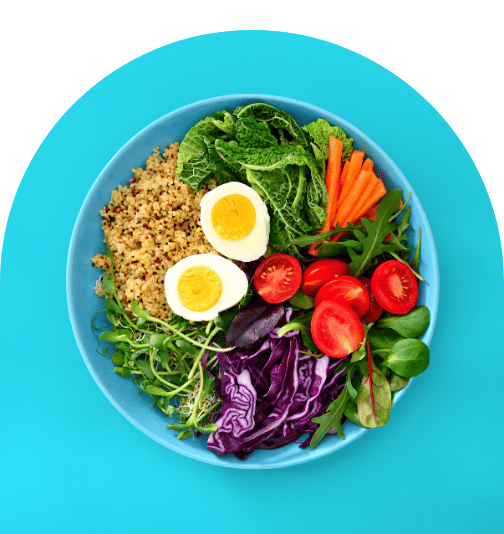How to Eat the Rainbow and Resolve Unexplained Infertility
Phytonutrients, the natural compounds found in fruits, vegetables, and other plant-based foods, are one of the most overlooked aspects of optimizing both male and female fertility. It’s not just about adding color to our meals; adding enough phytonutrients to our diet is crucial to support reproductive health, reduce oxidative stress, and balance hormone levels.
The Importance of Phytonutrients for Fertility
Phytonutrients are essential for couples looking to get and stay pregnant because they help support various bodily functions that contribute to optimal fertility.
These include:
- Toxin elimination – Phytonutrients help the body eliminate toxins that can negatively impact fertility by supporting liver function and detoxification pathways(1).
- Hormone metabolism – Phytonutrients, especially those found in cruciferous vegetables, can help regulate and metabolize hormones. This is critical for maintaining reproductive health(2).
- Improving sperm and egg quality – Phytonutrients like resveratrol, found in grapes and berries, can help improve the quality of eggs and sperm by reducing oxidative stress and protecting reproductive cells from damage(3, 4).
- Supporting implantation – Certain phytonutrients, such as those found in green leafy vegetables and citrus fruits, may help promote a healthy uterine lining and support successful embryo implantation(5, 6).
- Regulating ovulation – Certain phytonutrients in soy products, like isoflavones, can help regulate ovulation by modulating hormone levels and promoting hormonal balance(7, 8).
- Enhancing sperm motility – Compounds like lycopene in tomatoes and watermelon have been shown to improve sperm motility, which is necessary for successful fertilization(9, 10).
- Strengthening the immune system – A robust immune system is paramount for fertility, and phytonutrients help boost immune function by providing antioxidants and anti-inflammatory compounds.
Eating the Rainbow for Fertility
To harness the power of phytonutrients to boost fertility, focus on eating a wide variety of colorful fruits and vegetables—and choose organic whenever possible!
In other words, try to “eat the rainbow” – ensuring a mix of many colors on your plate each meal.
Each color represents different phytonutrients that offer unique health benefits:
- Red
Red foods, such as raspberries, pomegranates, and red cabbage, contain lycopene, an antioxidant that helps protect the reproductive organs and may improve sperm quality(9, 10).
- Orange and Yellow
Orange and yellow foods, like carrots, sweet potatoes, and mangoes, are rich in beta-carotene, which the body converts into vitamin A. Vitamin A is essential for reproductive health, as it supports the development of follicles in the ovaries and helps maintain a healthy uterine lining(11).
- Green
Green vegetables, particularly cruciferous vegetables like broccoli, kale, and Brussels sprouts, contain indole-3-carbinol (I3C) and diindolylmethane (DIM). These compounds help metabolize estrogen and support hormone balance, which is vital for female fertility(12).
- Blue and Purple
Blue and purple foods like blueberries, blackberries, and purple cabbage contain anthocyanins, powerful antioxidants that help reduce inflammation and protect reproductive cells from oxidative stress.
- White and Brown
White and brown foods, like garlic, onions, and mushrooms, contain allicin and other sulfur compounds that help support liver function and detoxification, which should be optimized for proper hormone balance and fertility.

Source: Naturally Healthy Concepts
Pairing Foods and Meal Ideas for Optimal Phytonutrient Intake
The idea of eating the rainbow each and every day can be overwhelming to some people—particularly if they aren’t used to thinking about their food strategically.
In fact, most people don’t get enough of a color variety—eight out of 10 Americans, according to research! But eating the rainbow doesn’t have to be complicated.
A simple way to “eat the rainbow” is to pair foods from different color categories in your meals. This straightforward strategy can help you maximize your phytonutrient intake without feeling overwhelmed by the idea of eating all the colors every day.
Here are some examples of this “color pairing” strategy in action:
- Spinach and berry smoothie: Combine spinach (green) with blueberries or strawberries (blue/purple and red) for a phytonutrient-packed breakfast or snack. While your smoothie may not look the prettiest, blending up your greens in a smoothie is a quick solution to pack in those nutrients—and still mask the taste. Bonus tip: Add a scoop of vegetable protein powder for an extra boost of nutrients and energy.
- Stir-fry rainbow veggies: Create a colorful stir-fry using red bell peppers, orange carrots, yellow squash, green broccoli, and purple cabbage. Cook with olive oil or other healthy fats and serve over brown rice or quinoa for added color, fiber, and whole grains.
- Sweet potato and kale salad: Roast sweet potato wedges (orange) and serve over a bed of massaged kale (green) with diced red onions (red/purple) and a sprinkle of sunflower seeds for healthy fats and zinc.
- Tomato and mushroom frittata: Combine organic eggs with diced tomatoes (red), sautéed mushrooms (white/brown), and fresh spinach (green) for a nutrient-dense breakfast or brunch option. Eggs are also an excellent source of vitamin D, vitamin B12, and choline, which are important for reproductive health.
- Cauliflower rice bowl with turmeric and veggies: Use cauliflower rice (white) as a base and top with turmeric-roasted chickpeas (yellow/orange), sautéed red and yellow bell peppers, and a handful of fresh parsley or cilantro (green) for added phytonutrients and flavor. Turmeric is known for its potent anti-inflammatory properties, thanks to its active compound curcumin, which can help support optimal fertility(13). For an extra dose of lean protein, include wild-caught salmon or organic chicken.
The Importance of a Balanced Fertility Diet
In addition to incorporating phytonutrient-rich foods, it’s essential to focus on a well-rounded fertility diet that includes:
- Healthy fats
Monounsaturated fats, found in olive oil, avocados, and nuts, and omega-3 fatty acids, found in fatty fish like wild-caught salmon, have been shown to improve fertility in both men and women(14).
- Lean proteins
Incorporating lean meats, fish, and vegetable protein sources like legumes and tofu can help support reproductive health and maintain a healthy weight.
- Complex carbohydrates
Opting for whole grains, legumes, and starchy vegetables instead of refined carbohydrates like white bread and pasta can help regulate blood sugar levels and support optimal fertility(15).
- Limiting processed and high-sugar foods
Reducing fast food, sugary snacks, and high-calorie beverages can help you maintain a healthy weight, reduce inflammation, and resolve many factors that affect your reproductive health(16).
Addressing Underlying Root Causes of Unexplained Infertility
If you’ve been given a diagnosis of unexplained infertility, don’t despair. There is ALWAYS a reason for your inability to conceive naturally.
That’s what we specialize in our practice – and we have an 80% success rate in getting couples pregnant… when nothing else has worked before!
Take the first step toward optimizing your fertility today.
We’ve helped countless couples just like you succeed in their fertility journey, even when starting a family later in life. Let us help you write your own success story.
In addition to supporting overall reproductive health, phytonutrients can help address some of the underlying risk factors of unexplained infertility, such as:
- Inflammation
Chronic inflammation can negatively impact fertility by disrupting hormone balance and damaging reproductive tissues. Phytonutrients have potent anti-inflammatory properties that can help reduce inflammation throughout the body(17).
- Oxidative stress
Oxidative stress happens when the body’s free radicals and antioxidants are imbalanced. This imbalance can damage reproductive cells and contribute to fertility issues. Phytonutrients are rich in antioxidants that help neutralize free radicals and protect reproductive tissues(18).
- Nutrient deficiencies
Certain nutrient deficiencies, such as vitamin D, folate, and zinc, can contribute to infertility. Phytonutrient-rich foods are often also excellent sources of these essential nutrients, helping address deficiencies that may impact fertility(19).
Conclusion
Incorporating a wide variety of phytonutrient-rich foods into your fertility diet is a simple yet powerful way to support reproductive health and address unexplained infertility. By eating the rainbow and ensuring you consume a variety of fruits, vegetables, and complex carbohydrates, as well as high-quality lean proteins and healthy fats, you can give your body the essential nutrients it needs to grow a baby!
Remember, making positive lifestyle changes and food choices can increase your chances of conception and have a significant positive impact on your reproductive health.
If you are struggling with fertility issues, consider tuning into our Masterclass. This free mini-class shows you how to address the root cause factors of most fertility blockers so you can have the happy, healthy family you’ve always dreamed of… even if you’re starting later in life.











